Funding to local actors: evidence from the Syrian refugee response in Türkiye: Chapter 3
Funding to local and national actors
DownloadsDespite global commitments to increase direct funding to local and national actors (LNAs) and to share data on such funding, there is a lack of timely and comprehensive information around how, and how much, funding passes through international organisations and ultimately reaches local implementing actors. This section aims to address this information gap within the Türkiye Syrian refugee response context, answering the following questions:
- What proportion of international funding reaches LNAs directly and indirectly through an intermediary organisation?
- What type(s) of local actors are receiving funding?
- How do LNAs currently access international funding?
- Which international organisations channel the most funding to LNAs?
The following information is based on data collected directly by DI and TMK from donors and international and national recipients of international grant funding for the Syrian refugee response in Türkiye, complemented by data from publicly available sources. This includes both development and humanitarian grant funding, both of which were included in our data collection to reflect the breadth of refugee financing available (see ‘ Methodology ’ section).
Tracking funding flows to local and national actors
Figure 7: Overall picture of funding flows for the Syrian refugee response
Total grant funding to Türkiye for the Syrian refugee response, by first and second-level recipients (volumes), 2019–2020 aggregate
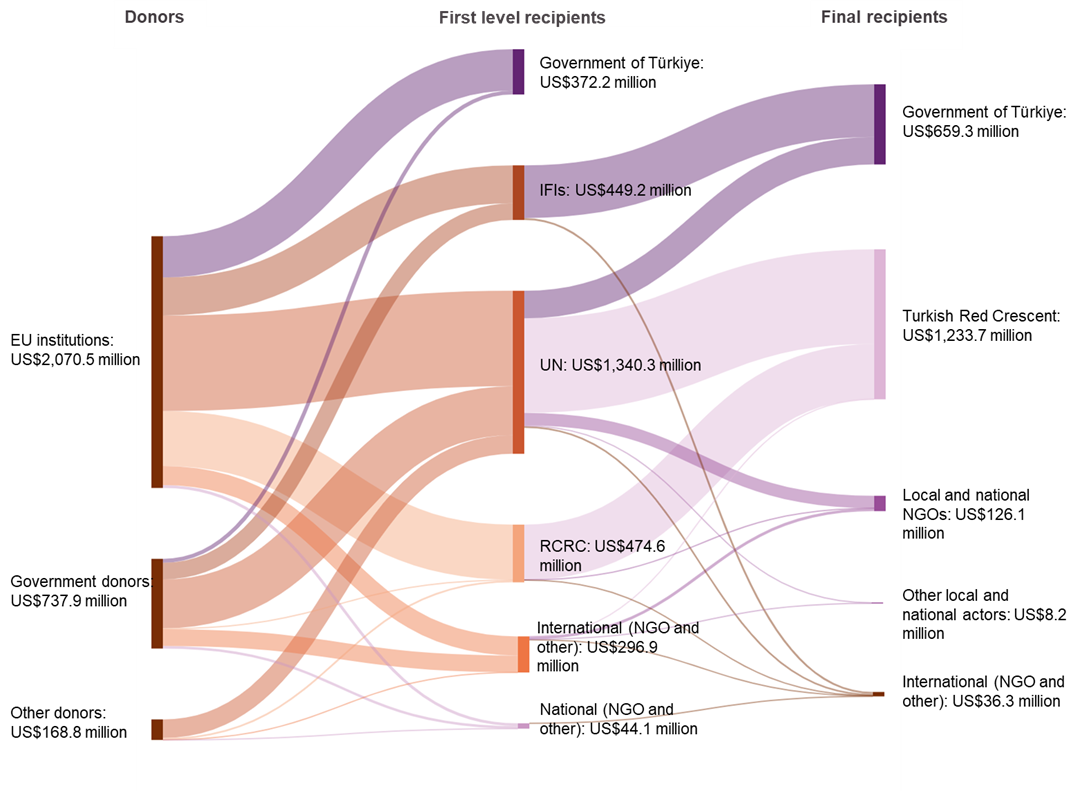
Chart showing overall picture of funding flows for the Syrian refugee response
Source: Development Initiatives based on survey data provided directly by donors and intermediaries, UN Office for the Coordination of Humanitarian Affairs (UN OCHA)’s Financial Tracking Service (FTS), OECD DAC Creditor Reporting System (CRS), International Aid Transparency Initiative (IATI) data and publicly accessible project lists for individual organisations.
Notes: Data is in current prices. 'Other donors' category includes unknown, private individuals and organisations and other global pooled funding mechanisms. 'Other local and national actors' category includes professional associations and academic institutions. 'International (NGO and other)' category mainly includes INGOs and other bilateral actors such as the German Agency for International Cooperation (GIZ). IFIs = international financial institutions; RCRC = International Red Cross and Red Crescent Movement.
In 2019 and 2020, most international grant funding for the Syrian refugee response was provided to international actors, and only a small proportion was directly given to LNAs . As a result, nearly all funding that reaches LNAs, especially L/NNGOs, for the Syrian refugee response, is channelled through an international intermediary (see Figure 7 ).
- In 2019 and 2020, our study identified that US$3.0 billion of international grant funding was provided to Türkiye for the Syrian refugee response (US$1.4 billion in 2019 and US$1.6 billion in 2020). Of this, 86% was first channelled to international actors, of which nearly half went to UN agencies (45%).
- In total, just 14% of international grant funding for the Syrian refugee response in 2019 and 2020 was channelled directly to LNAs, of which the vast majority went to GoT.
- Just 1% of international funding in 2019 and 2020 was directly provided to L/NNGOs. This is largely consistent with global trends; in 2019 and 2020, 0.5% of international humanitarian assistance was channelled direct to L/NNGOs [1] and 2% of all bilateral ODA was directly channelled to civil society organisations in 2018 and 2019. [2]
- Of the total US$3.0 billion of international grant funding provided to Türkiye for the Syrian refugee response in 2019 and 2020, our research found that US$2.4 billion ultimately reached LNAs. However, of this just 17% was channelled directly to LNAs by donors and 83% was first passed through an intermediary organisation.
Figure 8: Most direct funding for the refugee response in Türkiye is received by international actors
Direct recipients of grant funding for the Syrian refugee response in Türkiye, annual percentage shares, 2019–2020
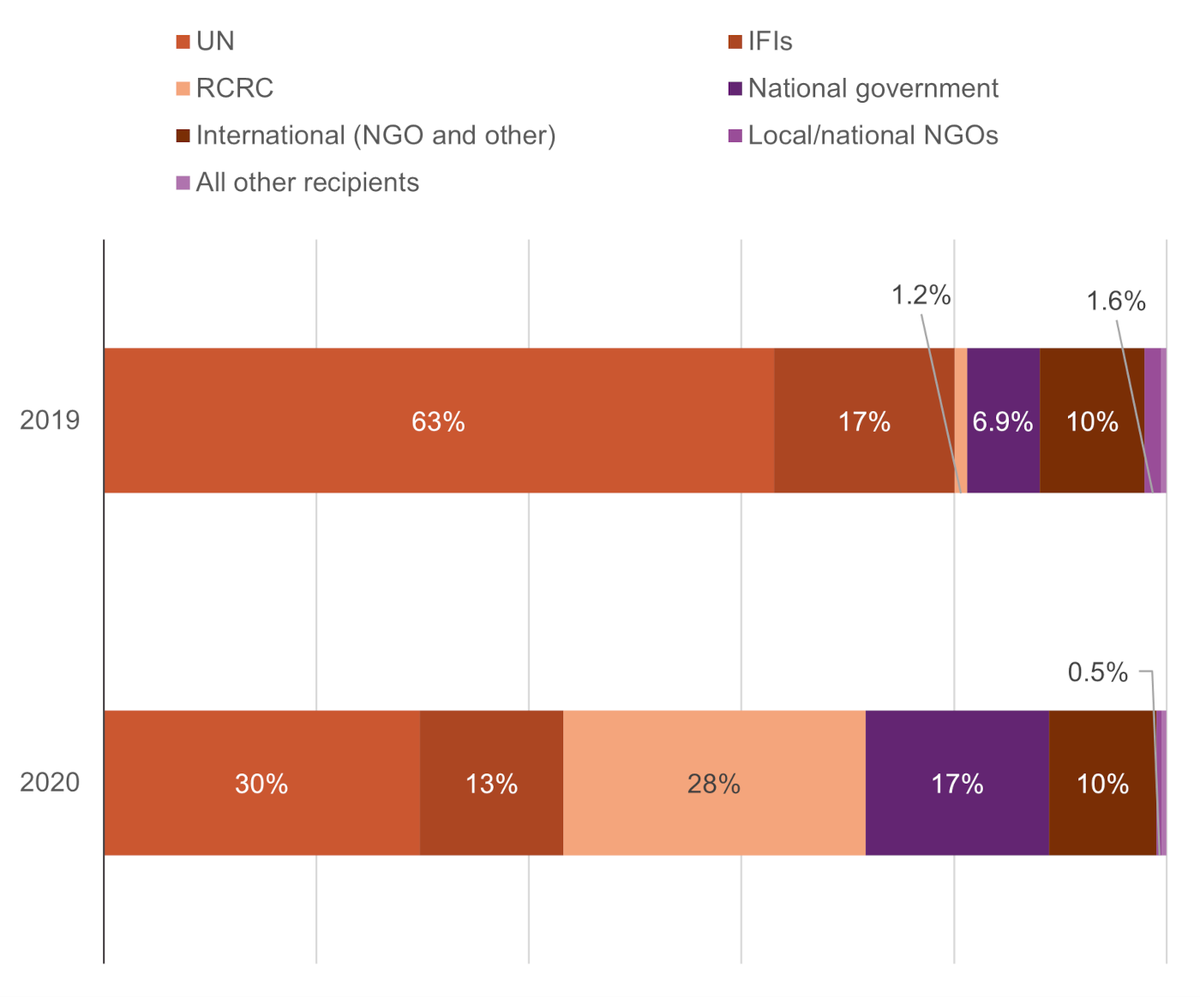
Chart showing that most direct funding for the refugee response in Türkiye is received by international actors
Source: Development Initiatives based on survey data provided directly by donors and intermediaries, UN Office for the Coordination of Humanitarian Affairs (UN OCHA)’s Financial Tracking Service (FTS), OECD DAC Creditor Reporting System (CRS), International Aid Transparency Initiative (IATI) data and publicly accessible project lists for individual organisations.
Notes: Data is in current prices. ‘All other recipients’ category includes Turkish Red Crescent, academic institutions, local government, professional associations and other categories. RCRC = International Red Cross and Red Crescent Movement, here this includes funding to the International Federation of Red Cross and Red Crescent Societies, the German Red Cross and the Norwegian Red Cross.
While international actors received the vast majority of direct funding in 2019 (91%) and 2020 (82%), the balance of recipients changed in 2020 (see Figure 8 ). Funding to the UN fell, while funding to the International Federation of Red Cross and Red Crescent Societies (IFRC) and the GoT increased.
- In 2019, 91% (US$1.2 billion) of direct funding for the Syrian refugee response was channelled to international actors. The largest recipients were UN agencies who received 63% of total funding (US$861 million), followed by IFIs (17%) and INGOs (10%).
- In 2020, international actors remained the largest direct recipient of international funding (82%) however the share between actors changed significantly, with UN funding nearly halving to 30% (US$480 million), as ESSN funding was transitioned to the International RCRC Movement (28% share, up from 1.2%).
Direct funding to LNAs, especially L/NNGOs, was small in both years. While direct funding to the government grew in 2020, funding to L/NNGOs fell, and donors continued to channel more funding to INGOs than L/NNGOs.
- Total direct funding to LNAs increased from 8.8% in 2019 to 18% in 2020. This was mainly funding to the GoT, which drove the overall increase.
- Direct funding to the national government grew from 6.9% of total funding (US$94 million) in 2019, to 17% (US$279 million) in 2020.
- Direct funding to L/NNGOs fell from US$22 million (1.6%) in 2019 to US$8.4 million (0.5%) in 2020. Of this direct funding in 2019, around half went to one national NGO. By comparison, INGOs received 5.9% of total direct funding in both years.
Box 3
Funding tracking studies
Tracking funding to LNAs is notoriously difficult given the lack of consistent and complete data reported to funding tracking platforms such as FTS, which necessitates primary data collection. This also makes it difficult to compare progress on the localisation of funding between crisis contexts. However other country studies into funding flows to LNAs offer some limited parallels to the findings of this study in Türkiye, and show the extent to which existing dynamics relating to international funding in Türkiye seem to reflect practices taking place elsewhere.
Recent studies tracking humanitarian funding to LNAs in Uganda and Bangladesh, [3] and South Sudan and Somalia [4] found that limited funding is directly provided to LNAs, and what is provided directly is mainly limited to government institutions. In 2015, local and national humanitarian actors in Bangladesh received 20% (US$12 million) of total humanitarian funding identified by the study directly, while just 0.2% reached local and national humanitarian actors directly in Uganda. In both cases, this was entirely provided to government institutions and no funding was provided directly to L/NNGOs. Similarly in Somalia, just 3.5% of humanitarian funding in 2017 was directly provided to local and national humanitarian actors and 4.3% in South Sudan, of which the majority was to national state actors. This compares with 9% in 2019 and 18% in 2020 reaching LNAs directly in Türkiye, which was also mainly to the GoT. Overall, however, the volumes and proportion of total funding reaching LNAs (both directly and indirectly) is notably higher in Türkiye than other contexts. In 2019, 83% of total international funding identified for this study was directly or indirectly transferred to LNAs, compared to 39% in Bangladesh and 12% in Uganda in 2015, and around 10–13% in Somalia and South Sudan in 2017.
These comparisons are limited by the different scopes of each study and country contexts. While this research looked at both humanitarian and development funding for the Syrian refugee response, previous studies have focused on humanitarian funding only. Therefore, it should be emphasised that comparisons between studies tracking funding to LNAs in different contexts are limited due to the different methodologies, reinforcing the need for greater transparency in how funding reaches LNAs and the importance of better consistency in reporting.
Figure 9: LNAs implement the majority of refugee programming yet are not able to access funding directly from donors
Total international funding by recipient type (direct and indirect), 2019–2020
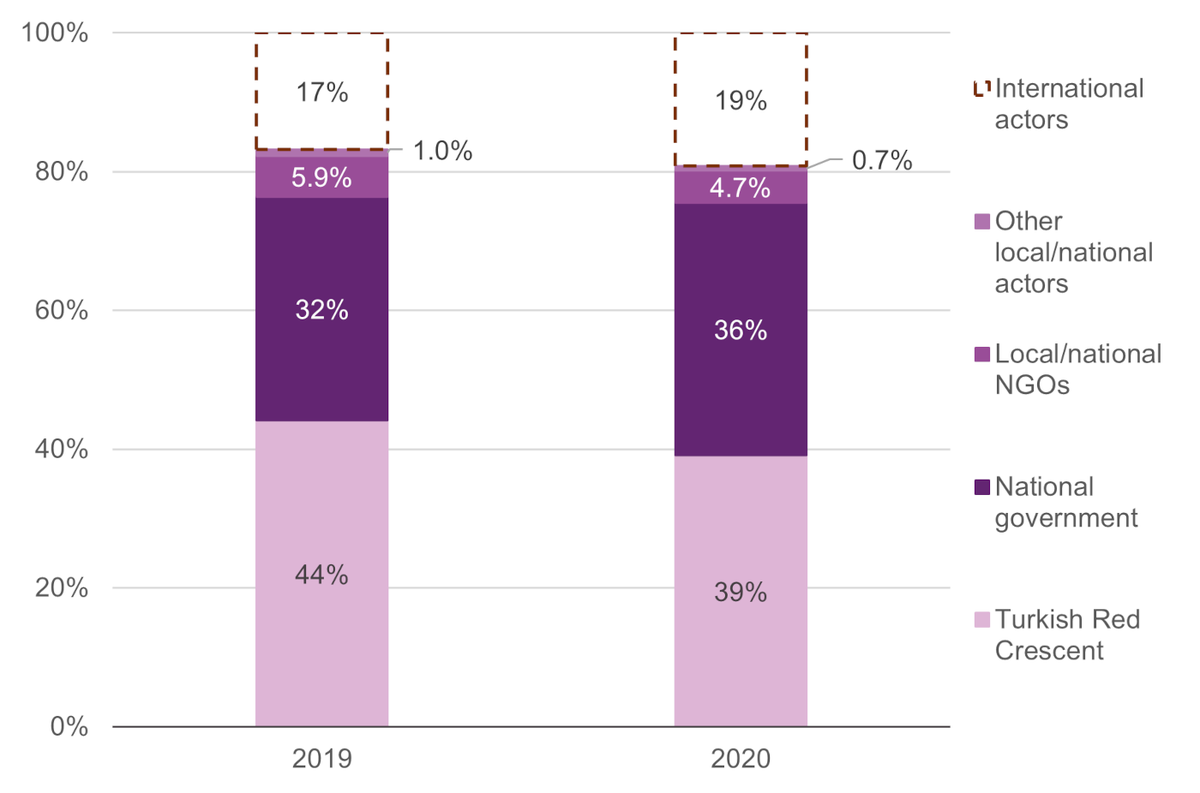
Chart showing that LNAs implement the majority of refugee programming yet are not able to access funding directly from donors
Source: Development Initiatives based on survey data provided directly by donors and intermediaries, UN Office for the Coordination of Humanitarian Affairs (UN OCHA)’s Financial Tracking Service (FTS), OECD DAC Creditor Reporting System (CRS), International Aid Transparency Initiative (IATI) data and publicly accessible project lists for individual organisations.
Notes: ‘Other local/national actors’ includes local government, professional associations, academic institution and other categories.
Most international funding for the refugee response in 2019 and 2020 was ultimately channelled to LNAs (83% in 2019 and 81% in 2020) either directly or indirectly (passing through at least one intermediary). This indicates both the extensive role LNAs play in implementing the refugee response, and the existing discrepancy in access to direct funding for LNAs and international actors.
- The largest recipient of total international funding was the TRC. The TRC received 44% (US$603 million) of total funding in 2019 and 39% (US$631) in 2020, in part due to it being the implementor of the ESSN programme in 2020 (see Box 4 ). Despite being the largest national implementing organisation for internationally funded refugee response programmes, our data collection did not capture any direct funding provided from donors to the TRC in 2019 and 2020.
- The government was the second largest recipient, receiving 32% (US$443 million) of total funding in 2019 (both directly and indirectly). This grew to 36% (US$586 million) in 2020 due to an US$185 million increase in direct funding. As a result, the proportion reaching the government as direct funding grew from 21% to 47%.
- Of total funding, 5.9% (US$81 million) was ultimately passed to L/NNGOs in 2019. This slightly fell in 2020 to 4.7% (US$75 million), despite rhetoric about increasing funding to local actors during the Covid-19 pandemic response.
Figure 10: Local NGOs, refugee-led and women’s organisations receive very small volumes of international funding
Total funding to local and national NGOs by NGO type (direct and indirect), 2019–2020
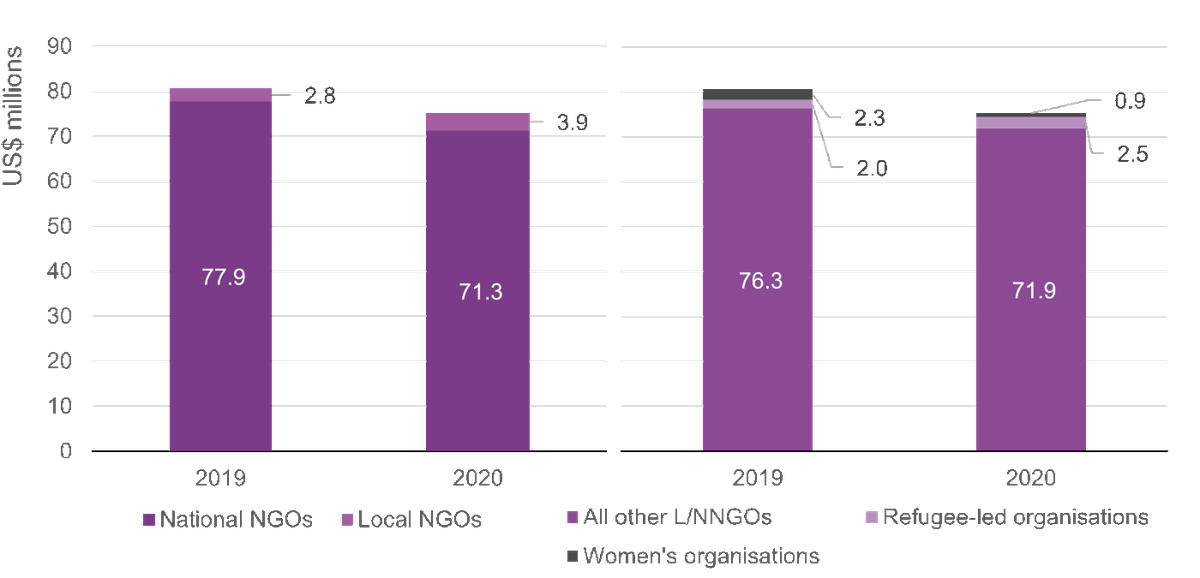
Bar chart showing total funding to local and national NGOs by NGO type (direct and indirect), 2019–2020
Source: Development Initiatives based on survey data provided directly by donors and intermediaries, UN Office for the Coordination of Humanitarian Affairs (UN OCHA)’s Financial Tracking Service (FTS), OECD DAC Creditor Reporting System (CRS), International Aid Transparency Initiative (IATI) data and publicly accessible project lists for individual organisations.
Notes: Data on the breakdown of funding to international actors by direct and indirect funding was not comprehensively provided. Data is in current prices. L/NNGO = local/national NGO.
Very little funding reached local, refugee-led or women’s organisations in Türkiye in 2019 and 2020.
- International funding for civil society in Türkiye is overwhelmingly provided to national NGOs, rather than local NGOs. Of all funding to L/NNGOs in 2019 and 2020, just 4.3% (US$6.7 million) was provided to local NGOs (US$2.8 million in 2019 and US$3.9 million in 2020). This represents 0.23% of total funding.
- Of total funding to L/NNGOs in 2019 and 2020, 2.9% (US$4.5 million) was provided to refugee-led organisations (US$2.0 million in 2019 and US$2.5 million in 2020) and 2.1% (US$3.2 million) to women’s organisations (US$2.3 million in 2019 and US$0.9 million in 2020).
- Of the total funding to the Syrian refugee response in Türkiye, refugee-led organisations received 0.15% in 2019 and 2020, while women's organisations received only 0.11%.
Funding mechanisms and accessibility
As outlined above, LNAs access most international funding for the Syrian refugee response through an intermediary organisation. IFIs predominantly fund the GoT while UN agencies partner with the TRC, GoT and L/NNGOs to implement programming for Syrian refugees.
Figure 11: L/NNGOs receive most funding through the UN
Total direct and indirect funding to L/NNGOs by donor type, 2019–2020
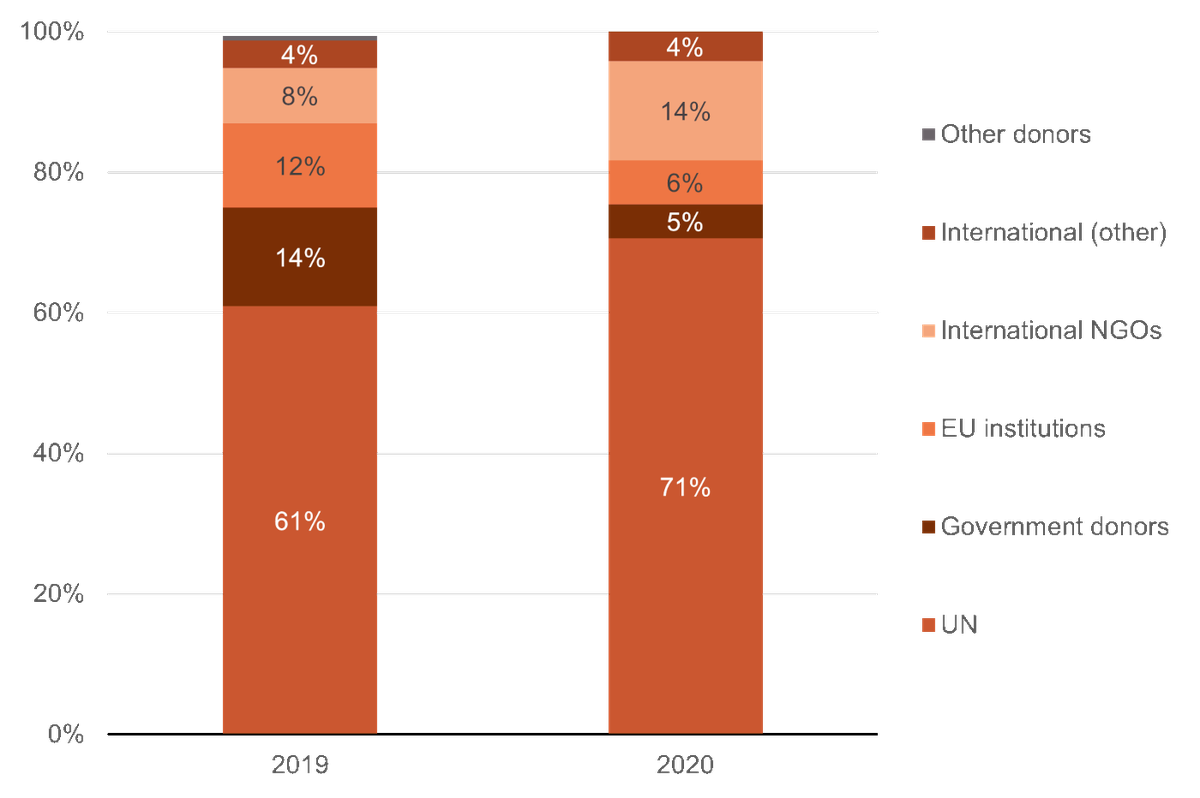
Chart showing that L/NNGOs receive most funding through the UN
Source: Development Initiatives based on survey data provided directly by donors and intermediaries, UN Office for the Coordination of Humanitarian Affairs (UN OCHA)’s Financial Tracking Service (FTS), OECD DAC Creditor Reporting System (CRS), International Aid Transparency Initiative (IATI) data and publicly accessible project lists for individual organisations.
Notes: This chart includes both direct and indirect funding to local/national NGOs. The ’International (other)’ category includes funding from international actors, here from the German Agency for International Cooperation (GIZ). The ‘Other donors’ category includes funding from private individuals and organisations and the International RCRC Movement.
The UN is the largest indirect source of funding for L/NNGOs working on the Syrian refugee response , while INGOs provide smaller volumes, and government donors provide some direct contributions (see Figure 11 ). L/NNGOs generally apply for funding through specific calls for proposals either directly or through invitation by international partners. In certain cases, local actors were able to raise funds from international partners that they were already working with as they expanded their programmes to include response to the Syrian situation. Cluster meetings, platforms that bring together donors and NGOs, as well as funding databases were identified as useful for learning about funding opportunities.
- The share of total funding reaching L/NNGOs from UN agencies increased from 61% (US$49.5 million) in 2019 to 71% (US$53.1 million) in 2020, despite the overall funding to UN agencies from donors falling in 2020.
- Funding from INGOs also increased both in terms of volume and proportion, from 8% (US$6.4 million) of total funding to L/NNGOs in 2019, to 14% (US$10.6 million) in 2020. This was offset by a drop in direct funding from the EU, from 12% (US$9.8 million) of total funding to L/NNGOs, to 6% (US$4.7 million) and a drop in direct funding from government donors, from 14% (US$11.4 million) to 5% (US$3.6 million).
In total, the UN passed on the majority (84%) of the funding it received in 2019 and 2020 to implementing partners. The largest recipient of UN funding was the TRC (58%) followed by the government (16%). Our study identified that 7.7% was passed on to L/NNGOs, compared to 0.7% that was passed on to INGOs. By contrast, INGOs seem to implement much more programming directly. The INGOs included within our sample passed on just 13% of their funding to other implementing partners of which 9.6% was to L/NNGOs and 3.1% to other INGOs.
Case study
Mavi Hilal’s experiences of indirect funding
Uluslararası Mavi Hilal (International Blue Crescent Relief and Development Foundation) was officially established in Türkiye in 2000 and is one of Türkiye’s largest and oldest humanitarian NGOs. With ‘special consultative status’ at the UN Economic and Social Council (ECOSOC) and the first NGO in Türkiye to receive the Core Humanitarian Standard, Mavi Hilal has been active in responding to both domestic and international humanitarian disasters. Since 2011, Mavi Hilal has been providing protection, livelihoods, education and health support for Syrian refugees in Türkiye. Mavi Hilal access international funding through UN agencies and INGOs and has not been able to access funding directly from donors despite its many years of experience. Mavi Hilal reported that this affects them in several ways: firstly, it is not able to decide project objectives and priorities, or input meaningfully into programme design, which can lead to a ‘subcontracting’ relationship with intermediary organisations. International organisations do not consistently share the overhead funding provided by donors with their local partners, meaning organisations like Mavi Hilal are unable to access a significant source of funding that could be used for expanding its capacities, diversifying its donor base and investing in its organisational sustainability. In addition to being unable to recover overhead costs, the distribution of management costs in the projects are reported to reflect asymmetric power dynamics. For instance, coordination costs are mainly allocated to the lead organisation meaning that they have to deal with a project coordinator who is often distant from the field. Moreover, there is a perception that while the work done by the lead and local organisation is highly similar, the local organisation is not able to pay salaries on par with the intermediary organisations. This can lead to the loss of highly qualified personnel to international partners.
Figure 12: Most funding that is passed on by an intermediary is humanitarian assistance
Total grant funding for the Syrian refugee response by assistance type, 2020
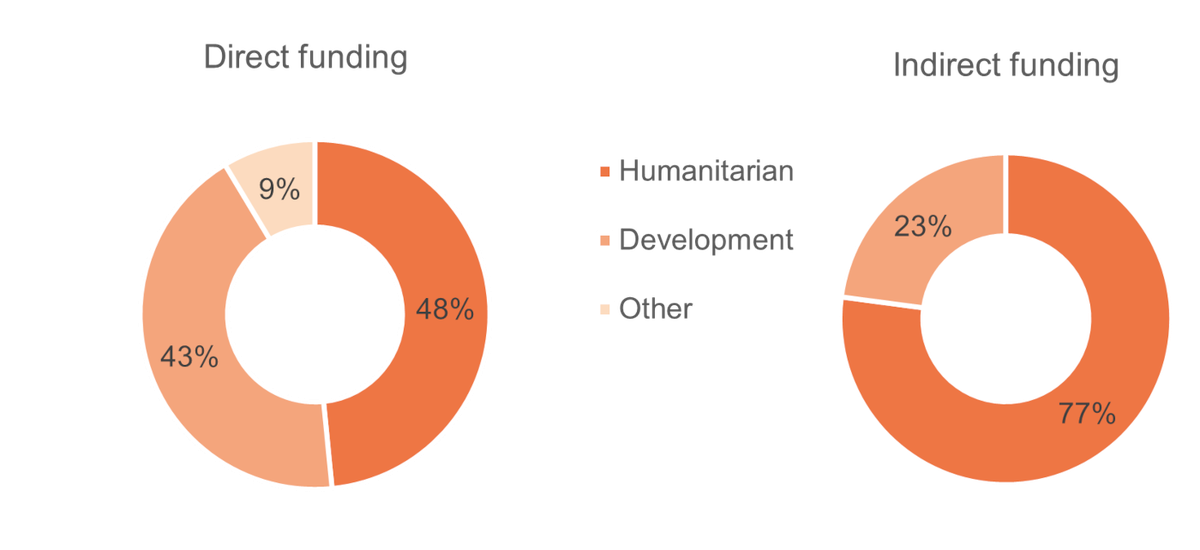
Chart showing that most funding that is passed on by an intermediary is humanitarian assistance
Source: Development Initiatives based on survey data provided directly by donors and intermediaries, UN Office for the Coordination of Humanitarian Affairs (UN OCHA)’s Financial Tracking Service (FTS), OECD DAC Creditor Reporting System (CRS), International Aid Transparency Initiative (IATI) data and publicly accessible project lists for individual organisations.
Notes: ‘Other’ includes funding amounts from unknown donors and unknown budgets, used in the donors dataset to reconcile total funding.
The type of funding available to LNAs has been predominantly humanitarian, especially for L/NNGOs . While most funding is provided by donors to the Syrian refugee response in Türkiye as humanitarian assistance (though the proportion of development assistance has increased, see Figure 4 ), the funding LNAs receive is disproportionately humanitarian.
- Based on data collated from intermediaries, the majority of funding that was passed on by an intermediary organisation in 2020 was humanitarian (77%). By comparison, only 48% of total funding provided by donors in 2020 was humanitarian assistance.
- Nearly all the development funding passed on by intermediaries from donors is provided to the government (91%), meaning L/NNGOs are able to access only humanitarian funding.
Box 4
Transition to government systems: ESSN funding
The Emergency Social Safety Net (ESSN) programme is the EU’s largest basic needs cash transfer programme. It is funded by the EC Department of Humanitarian Aid and Civil Protection (ECHO), using finance mobilised through the FRIT. The ESSN programme has been implemented through the World Food Programme and, under FRIT 2, the IFRC. Both have subcontracted the TRC to deliver the programme through its Kızılaykart cash assistance platform, in coordination with the Ministry of Family, Labour and Social Services. The ESSN has become a significant source of stable income for 1.7 million Syrian refugees and other vulnerable refugee households in Türkiye, who receive 155 Turkish Lira in monthly cash assistance per family member. [5] Since 2021 a portion of the ESSN programme funding is being channelled directly to the government, funded by the EC Directorate-General for Neighbourhood and Enlargement Negotiations (DG NEAR), rather than ECHO – meaning a shift from humanitarian to development funding. The aim of this complementary ESSN programme (C-ESSN) is to provide additional support to the most vulnerable households who struggle to meet their basic needs. C-ESSN funding is channelled through the Instrument for Pre-Accession and is therefore able to be directly implemented through national systems, unlike ECHO funding, with the Ministry of Family, Labour and Social Services and TRC implementing the programme. [6] Transitioning ESSN funding from humanitarian to development budgets allows the EU to directly support Turkish actors. In 2018, the GoT published an ESSN exit strategy, outlining a transition from basic needs to livelihoods to reduce dependence on the ESSN. [7] This follows in the direction of EU support to the health sector in Türkiye, which has shifted from humanitarian funding lines to a DG NEAR-funded health programme.
Barriers to funding for local and national actors
Overall, international funding for LNAs in response to the Syrian refugee crisis in Türkiye has increased. In particular, the GoT has become an increasingly large direct recipient of international grant funding, as more funding is channelled through development financing instruments (see Figure 5 ). However, there are significant barriers for other LNAs, especially L/NNGOs, to access direct funding which can reduce transaction costs and increase effectiveness.
Donor regulations prevent L/NNGOs from being able to directly access some of the largest envelopes of funding for the Syrian refugee response in Türkiye. L/NNGOs have effectively been excluded from receiving direct funding through the FRIT as it is channelled through instruments which are not directly accessible by civil society (except the EUTF). The primary EU humanitarian and development financing instruments used to channel FRIT funds to Türkiye cannot directly fund L/NNGOs and can only fund certain international and national government actors. [8] This includes ECHO funding which accounted for 47% of the first tranche of the FRIT. Only the EUTF can fund L/NNGOs directly, however this mechanism was not used in the second tranche.
While information about calls and tenders is often accessible through online platforms and networks, eligibility criteria imposed by the donors was reported by interviewees as one of the main barriers to accessing funds directly . Formal eligibility requirements include international NGO status, registration requirements, the size of grants previously managed, experience and organisation size, all of which are difficult for smaller L/NNGOs in particular to meet.
In other cases , donor preferences and capacities mean they prefer to channel larger amounts of funding to fewer, larger actors, mainly multilateral organisations . International intermediaries such as UN agencies and INGOs also generally prefer to fund larger, well-established L/NNGOs because they can absorb larger sums of money, are more familiar with funding proposal processes and can better meet the stringent compliance requirements. The requirements put in place by donors mean that accessing funds directly is resource intensive and requires specialist skills that not all L/NNGOs have. This can discourage L/NNGOs from applying for international funding in the first place and limits the opportunities for smaller, local NGOs to access international funding directly or indirectly. Exceptions to this include the Local Initiatives Fund for Türkiye (LIFT), a pooled fund which specifically targeted smaller local organisations (see case study below).
Complexities in the legal and regulatory environment also influence partnerships between international actors and national civil society organisations . Some international organisations reported that the complex operating environment in Türkiye has compelled them to partner with organisations that have close relationships with state institutions, limiting their partner choices. INGOs reported that they also face challenges in navigating the complex regulatory environment in Türkiye with non-compliance often resulting in fines. A lack of clarity and understanding of the law can mean that INGOs hold themselves back from expanding partnerships with local organisations further as part of perceived risk management. Nevertheless, some INGOs seek ways to partner with local and national civil society organisations despite these restrictions, for example one INGO reported to sign contracts with L/NNGOs through their headquarters, rather than at the country level, to overcome regulatory issues around partnering with local actors.
Case study
Increasing access to funding for small L/NNGOs: LIFT programme
The German Federal Ministry for Economic Cooperation and Development (BMZ)-funded Community Centres and Local Initiatives Project (CLIP) has been implemented by the German Agency for International Cooperation (GIZ) since 2017, with the aim of supporting community centres providing social services for refugees and vulnerable Turkish households through ‘localised assistance interventions’. Since 2019, CLIP has also implemented the Local Initiative Fund in Türkiye (LIFT), a multi-donor initiative with co-funding from ECHO and BMZ. [9] LIFT was designed to directly address the barriers smaller or less experienced L/NNGOs face in accessing international funding, as well as to expand community-based protection and specialist services to underserved communities at risk of being left behind. LIFT was contracted through three calls for proposals, the largest for projects up to EUR 500,000 and two for grants capped at EUR 50,000 with the aim of attracting smaller community-based organisations. In addition, some of the calls were restricted to specific provinces to fulfil a known supply gap in service provision. Support was provided to applicants including open information sessions, capacity development training on proposal writing and a help desk available in three languages which interested organisations could consult for guidance about the application process. Importantly, grant proposals were also not restricted to English, which enabled smaller organisations, including refugee-led organisations, who previously found themselves automatically excluded from many funding calls, to apply. Ongoing capacity building support was also provided through LIFT throughout implementation. Support to local initiatives through LIFT was implemented in close coordination with state structures to facilitate a more sustainable support mechanism, for example by establishing referral systems.
LIFT received over 180 applications and in total, EUR 6.1 million has been allocated to 20 organisations, of which 10 are smaller organisations. [10] In 2019 and 2020, 21% of LIFT funding was provided to local organisations – much higher than the overall average of direct funding to LNAs for the Syrian refugee response – and 12% was awarded to refugee-led organisations. The LIFT mechanism was continued under CLIP 2 (2021–2023). [11] Several lessons were learned from this funding mechanism and incorporated: firstly, LIFT was initially funded by ECHO and was limited to protection activities, which was considered too narrow by partners. The additional funding from BMZ for LIFT under CLIP 2 meant partners could propose projects under more sectors. Secondly, despite the support provided to enable smaller organisations to access funding, the requirements were still too burdensome for some organisations, especially in provinces where the best-placed partners were small organisations that lacked experience in accessing and delivering larger-scale projects. To address this, an exploration fund was established to provide smaller grants to local organisations, with intensive support throughout the project design and implementation process. A peer support network was also established under CLIP 2 for LIFT recipients where smaller organisations were able to receive mentoring from more well-established organisations, including in advocacy, fundraising and other organisational development support.
L/NNGOs have limited opportunities for strategic engagement with donors, as they receive most funding indirectly, and are therefore less able to influence donor funding priorities. Opportunities for engagement between L/NNGOs and donors are mainly limited to the 3RP coordination mechanisms, of which L/NNGOs are active members. L/NNGOs can mainly only access project-based, often short-term funding grants, rather than longer-term strategic partnerships. As a result, donors often define the formal criteria for application as well as the priority areas, location and other features of projects. When the terms of the funds are defined by the donor, projects do not always match the shifting needs of the refugees on the ground as identified by L/NNGOs. For example, while it is widely known that Syrian refugees work in the informal sector, international funds do not cover this group of workers despite many local NGOs seeking to support them. Donors and L/NNGOs may also disagree on the classification of types of activities. For instance, advocacy around the rights of refugees may be seen as protection activities by donors but as social cohesion activities for L/NNGOs. Recent research has found that local and international actors have different expectations, priorities and understandings around protection advocacy. [12]
The movement toward more nexus and resilience programming in Türkiye may create further barriers for funding to L/NNGOs specifically. With an increase in development grant funding, FRIT 2 and post-FRIT funding trends have seen more funding being channelled to IFIs, which generally fund government institutions, and a decrease in funding to the UN, which acts as a key intermediary to L/NNGOs. Interviewees were clear that the direction of funding will increasingly be toward government actors, as well as the TRC. While this is promising in terms of further localising the response and integrating refugee support into national systems, ensuring L/NNGOs are also a part of ‘localisation’ is critical to the quality and effectiveness of the response as well as important in terms of preserving civic space.
Downloads
Notes
-
1
DI, 2021 Global Humanitarian Assistance Report, available at: /51e059#b6d1d3f6Return to source text
-
2
OECD, Aid for Civil Society Organisations. Published April 2021, available at: www.oecd.org/dac/financing-sustainable-development/development-finance-topics/Aid-for-CSOs-2021.pdfReturn to source text
-
3
Oxfam and DI, 2018. Money Talks: a synthesis report assessing humanitarian funding flows to local actors in Bangladesh and Uganda, available at: www.oxfam.org/en/research/money-talks-synthesis-report-assessing-humanitarian-funding-flows-local-actors-bangladeshReturn to source text
-
4
HPG, 2018. Funding to local humanitarian actors – evidence from South Sudan and Somalia, available at: https://cdn.odi.org/media/documents/12459.pdfReturn to source text
-
5
ECHO, The Emergency Social Safety Net (ESSN): https://ec.europa.eu/echo/essn_enReturn to source text